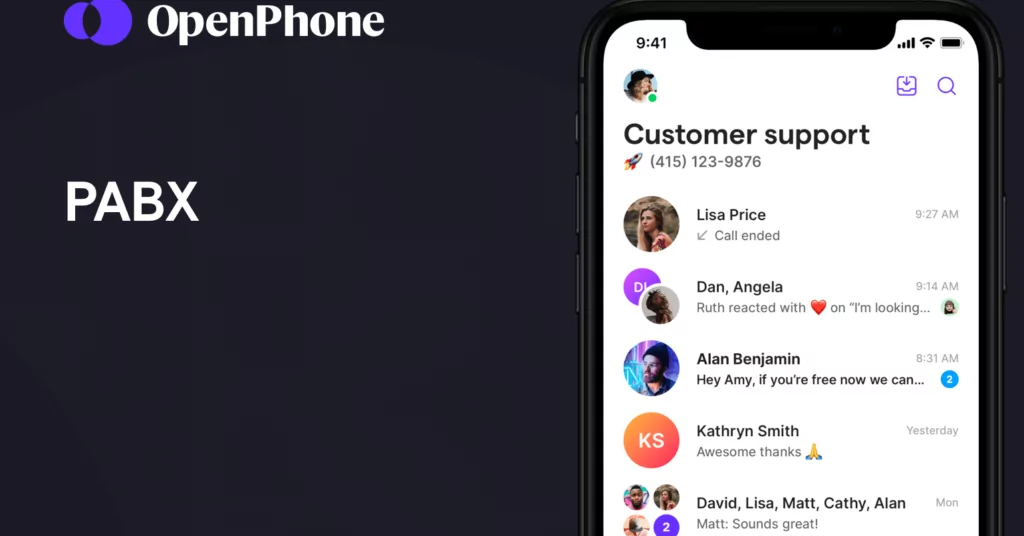Working smarter, not harder, is a goal that every great team strives to achieve. Naturally, when seeking a new business phone system, it’s easy to be captivated by any option that’s advertised as automatic. (We get it — we get googly-eyed when we hear the word “automation,” too. ) But before you say “take my money” to the next company that offers you a private automatic branch exchange (PABX) system, you need to know what this term really means.
We’ll explain what PABX systems have to offer, how they differ from PBX systems, and what makes them great (and not so great).
What is PABX?
PABX is a type of telephone system that connects multiple landlines on one internal network. Rather than setting up completely different phone lines for every user, PABX lets you:
- set up extensions from the same phone number
- receive and make calls from a shared number with your team (some providers like OpenPhone even let you divide responsibility for incoming calls through round-robin distribution)
- easily route and transfer calls
- place internal calls and group calls
This way, you don’t need to invest in a brand-new telephone line each time you hire an employee, which could get incredibly expensive.
When you have a PABX system, it’ll automatically switch and connect your calls to the right extensions. PABX makes the call process as straightforward as possible for landline users.
How PABX differs from PBX
PABX systems are extremely similar to private branch exchange (PBX) systems. The main difference is the fact PABX systems fully automate the switching process.
Traditional PBX systems require businesses to hire human operators, who manually answer calls and connect callers to the right people or departments. You may have seen switchboard operators cast in popular historical TV shows like “Mad Men” or “The Marvelous Mrs. Maisel,” but they’re not commonly seen in modern day offices.
PABX systems, on the other hand, use electronic switching. The process is computerized, so people don’t need to manage it.
One more thing to note: manual PBX systems are rarely used these days. Traditional PBX is so outdated, the terms PBX and PABX are usually used synonymously. While teams relying on legacy technology and call centers often host PABX/PBX systems on-site, many companies today use solutions from providers hosted in the cloud.
How does a PABX system work?
PABX systems create an internal phone network that’s exclusively used by your company. Your phone system’s software and hardware — including landline phones, modems, and routers — aren’t shared with outside lines.
When you make internal calls, this allows you to simply dial an extension number and reach the correct team member without using the public switched telephone network (PSTN). Reaching people within your organization is incredibly simple.
Outgoing calls, on the other hand, use trunk lines to connect to the PSTN. Each trunk line can only support a limited number of extensions at once, so PABX systems can leave you susceptible to high call-volume issues.
With a PABX system, you can hire a receptionist to pick up and manually route incoming calls. But since there’s no need for manual switching, many companies set up an auto-attendant or interactive voice response (IVR), which provides an automated greeting and a list of phone options for callers to choose from — for example, “dial 1 for Spanish” or “dial 2 for customer support.” Based on your caller’s command, your PABX system will do its automatic connection magic — with zero manual effort. ✨
Pros of PABX
A PABX system can support your business in a variety of ways — but it’s not entirely perfect.
With no need for manual switching or a 1:1 employee-to-phone line ratio, PABX can simplify your phone communication and offer these three benefits. Here’s a rundown of what makes PABX great (and not so great).
1. No operators required
The most obvious perk of PABX is the fact that you don’t need humans working your switchboard at all times. Using an automatic switching system lets you focus on hiring team members who directly impact your clients — for example, sales representatives and customer support agents — which helps you save office space and cash.
2. Lower costs than traditional phone systems
The cost of operators isn’t the only expense you’ll be able to cut out. Unlike old-school phones, PABX (and even traditional PBX) ensures you don’t need individual numbers for every employee. This can mean significantly fewer costs, which makes it easier to grow your business.
3. Improved customer experience
Everybody makes mistakes — but automatic systems usually don’t. With PABX, your phone system can automatically route your callers to the right place using an auto-attendant or IVR. It leaves less room for miscommunication or human error, which means clients won’t have to deal with rerouting or unprepared agents.
Cons of PABX
PABX is without a doubt an improvement on traditional PBX, but when you’re using landlines, your phone system will still be outdated no matter what. Here are some of the downsides of standard, on-premise PABX.
1. Company-owned maintenance
Standard PABX systems use hardware that’s fully owned by your company. When things go wrong, this means your company is in charge of fixing it, too. You’ll need to have your own team of IT pros ready to help in case of emergency. This can lead to extra costs, which are never ideal when you’re trying to grow a business, on top of the $25-$60 monthly fee that the average business pays telephone companies for a single line.
With a voice-over IP-based PABX system, you’ll typically pay a set monthly subscription fee (OpenPhone starts at $15 per user per month) to use your phone system. Your VoIP service provider will take care of all the maintenance, and many offer complimentary customer support.
2. No free updates
Keeping your phone system up-to-date can get expensive when you’re using a standard PABX system. If you want to update (or upgrade) the features on your phone, you’ll have to purchase brand new landlines for each of your team members. Setting up those new phones will lead to even more expenses.
With a VoIP system, your phone is a digital app, so updating it is just as easy as updating any other application. If you want to access new phone features, all you need to do is upgrade your plan and add a small per-user fee to your monthly payment.
3. Poor device compatibility
A typical PABX system requires you to use and purchase landline phones that are compatible with the rest of your system. You don’t have flexibility when it comes to devices, and your team members won’t be able to work on the go.
With VoIP PABX, which offers internet-based phones, you can use any device that’s compatible with your service provider’s app. For instance, OpenPhone offers desktop, web, and mobile apps. If you want to hop from Android to iPhone to tablet to Mac, you’re all set to do so from anywhere you can get an internet connection! 💻
4. Limited business features
Standard PABX offers minimal telephony features like voicemail, call forwarding, and call waiting. Some advanced ones may also allow you to build a call center by letting team members pick up calls from the same phone numbers. However, it doesn’t offer the advanced features that modern VoIP systems have.
For example, OpenPhone offers integrations with business apps like Slack and Gmail to streamline your workflow, and automation features that go well beyond automatic switching. Want to send texting auto-replies to callers or schedule automated text messages with Zapier? We’ve got you covered.
Upgrade your PABX system with OpenPhone’s virtual PBX

Choosing a standard private automatic branch exchange system is a major step up from traditional PBX, which requires dedicated team members just to get calls to the right place. Choosing a VoIP-based PABX system is even better. Voice over Internet Protocol — otherwise known as VoIP, virtual PBX, or hosted PBX — can improve upon your average PABX system by using your internet connection to route every phone call.
With virtual PBX, you can cut costs further by eliminating the need for an in-house IT team and making updates and upgrades hundreds of dollars cheaper. Plus, you won’t be limited to one device, one place, or mediocre call features. Start your free trial of OpenPhone today.
